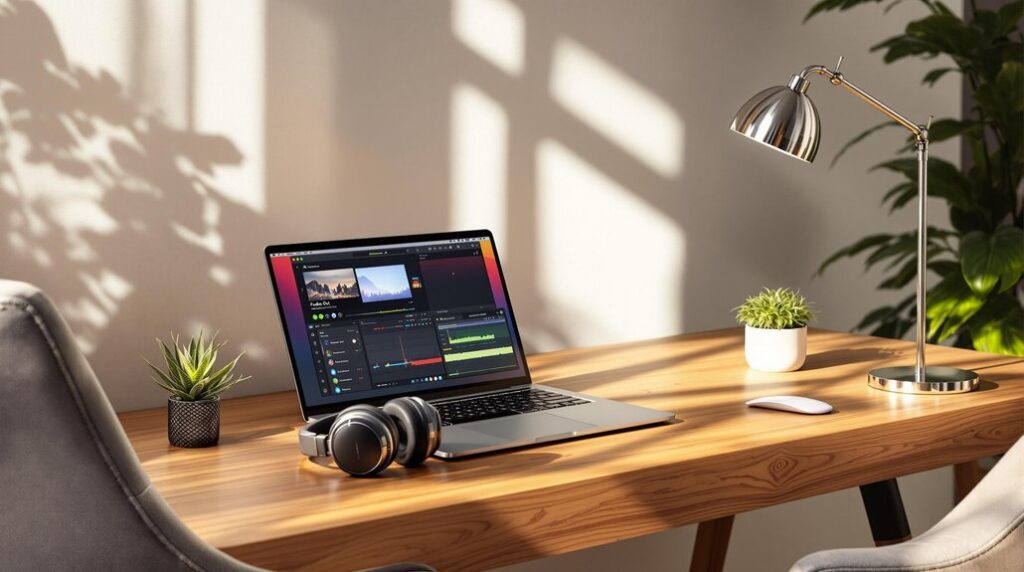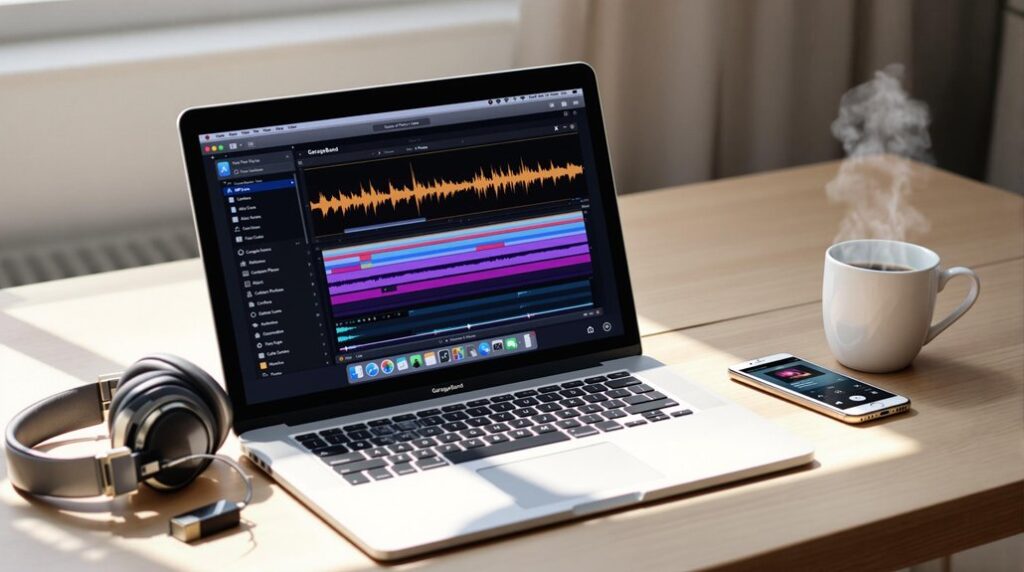Mastering loops in GarageBand transforms musical ideas into polished tracks utilizing its extensive library of genre-specific loops. Artists navigate the intuitive Loop Browser to filter and select from editable Green Loops, high-quality Blue Loops, and rhythm-focused Yellow Loops. Organize loops by key signature, tempo, and mood for streamlined project integration. The seamless interface allows users to alter loop length, layer different loop types, and experiment with instrument variations, enhancing creative expression. Advanced features, such as dynamic filtering and hotkey commands, optimize workflow efficiency. Access advanced techniques in these transformative elements to boost your audio production projects.
Key Takeaways
- Access the Loop Browser via the loop icon to explore and select loops by genre, instrument, or mood.
- Use Green Loops for customization, allowing instrument changes while maintaining the original melody.
- Integrate Blue Loops for high-quality, non-editable audio snippets that provide instant use in your project.
- Regularly update your loop library to include new and paid options for diverse audio creations.
- Master hotkey commands for efficient loop manipulation and seamless workflow in GarageBand projects.
Understanding GarageBand Loops
The foundation of musical creativity in GarageBand lies in its loops, a symphony of possibilities waiting to be explored. GarageBand offers an extensive library of royalty-free loops, meticulously categorized by genres, instrument types, and moods. This vast collection is pivotal for seamless instrument selection and creative project development.
Loops are classified into three distinct types: Green Loops, which are editable and offer versatility; Blue Loops, pre-recorded and non-editable for instant use; and Yellow Loops from the drummer track, providing dynamic rhythm. Each loop type displays key signature and tempo information, ensuring cohesion and alignment across your musical projects.
With the loop browser, users can efficiently filter loops to align with their artistic vision. The intuitive interface facilitates manipulating loops by dragging them into the workspace, adjusting length, and employing keyboard shortcuts for duplication, optimizing workflow.
How does one efficiently navigate the Loop Browser in GarageBand? Begin by accessing it through the loop icon strategically placed in the top right corner of the GarageBand interface. This gateway opens a world of sonic possibilities.
Utilize the dropdown menu to streamline your exploration, selecting specific genres, instruments, or moods, thereby narrowing down the vast array of loops to those most pertinent to your creative vision. The Loop Browser's dynamic filtering mechanism guarantees that only relevant loops populate your workspace, improving efficiency in sound selection.
New loops can be seamlessly integrated, categorized for future projects, boosting resource accessibility. Engage with the diverse loop types—green for MIDI, blue for audio, and yellow for drummer loops—each presenting unique auditory characteristics to enhance your compositions. Regular updates introduce new loops, including paid options, ensuring a diverse library.
Exploring Loop Variations
Exploring loop variations in GarageBand reveals a sophisticated palette of sonic textures, catering to the discerning audio creator. The platform offers three distinct loop types—Green, Blue, and Yellow—each serving unique purposes.
By selecting loops with a specific key, users can seamlessly integrate them into their new audio track. Key signature, tempo, and beat provide granular details, ensuring precise alignment with project requirements.
- Green Loops: Editable, allowing instrument changes while retaining the melody.
- Blue Loops: Non-editable, pre-recorded audio snippets ideal for high-quality sound.
- Yellow Loops: New Apple Loops designed for drummer track integration.
- Refined Search: Filter by genre, instrument, and mood in the Loop Browser.
- Layering Technique: Combine Blue Loops for sound quality with Green Loops for editing flexibility.
This method enhances creativity and sonic depth. Understanding the extensive suite of virtual instruments in GarageBand allows users to maximize their loop integration, expanding their creative possibilities.
Customizing and Organizing Loops
Release the potential of your GarageBand projects by mastering the art of customizing and organizing loops.
Begin by utilizing the Loop Browser's dropdown menu to refine your search by genre, instrument type, or mood, ensuring precision in your sound palette. Go ahead and categorize newly added loops in the Loop Browser for streamlined access in future sessions.
With Green Loops, you can alter the instrument while maintaining the melody, offering dynamic flexibility in sound design.
Arrange loops efficiently by employing sorting options to organize them by key signature, tempo, or beat. This method enhances workflow efficiency.
In addition, manipulate loop length by dragging the top right corner, achieving seamless integration into your track's arrangement, fostering a polished and cohesive audio project.
Advanced Loop Techniques
Building upon the foundational skills of customizing and organizing loops, advanced techniques offer a sophisticated layer of artistry to your GarageBand projects. The next time you engage with your composition, make sure to harness the Loop Browser's filtering options for streamlined creativity.
Experiment with Green Loops by altering instrument types to maintain melodic integrity while achieving unique sound variations. Utilize the 'L' key for the new looping feature, ensuring seamless connections by extending regions across your project's duration.
Precision is key—adjust loop lengths by manipulating the top right corner for impeccable timing and synchronization.
- Genre, instrument, mood filtering for quick loop searches
- Instrument changes in Green Loops for variation
- Seamless looping with the 'L' key
- Precise timing through loop length adjustments
- Combining loop types for enriched compositions
For effective audio manipulation, mastering hotkey commands such as Command + T, C, and V is essential to expedite your workflow.
Frequently Asked Questions
Does Garageband Have a Mastering Feature?
GarageBand lacks a dedicated mastering feature; however, utilizing built-in mastering techniques and audio effects like compression, EQ, and reverb on the Master Track can emulate mastering, achieving refined audio quality suitable for professional output.
How to Work With Loops in Garageband?
To effectively work with loops in GarageBand, utilize loop customization through the Loop Browser for precise filtering and arrangement. Leverage genre, instrument, and mood filters, and employ editing techniques, such as duplication and length adjustment, for ideal arrangement.
Can I Legally Use Garageband Loops?
Yes, GarageBand loops are legally usable in projects due to extensive loop licensing, mitigating copyright concerns. Users can creatively integrate them into compositions, retaining ownership, provided loops are not redistributed as standalone products. Always verify third-party loop agreements.
Can Garageband Be Used Professionally?
GarageBand can be utilized professionally, though it has limitations in advanced audio editing and mixing tools compared to professional alternatives like Logic Pro. Its robust loop library and regular updates, however, offer creative opportunities for musicians and producers.
Conclusion
The mastery of loops in GarageBand necessitates a thorough understanding of its loop browser, exploration of loop variations, and proficiency in customizing and organizing these elements. Employing advanced loop techniques can greatly enhance creative output and production quality. By integrating technical precision with creative expression, users can effectively manipulate loops to produce intricate and dynamic compositions. This synthesis of industry knowledge and practical application empowers producers to raise their musical projects to professional standards.




